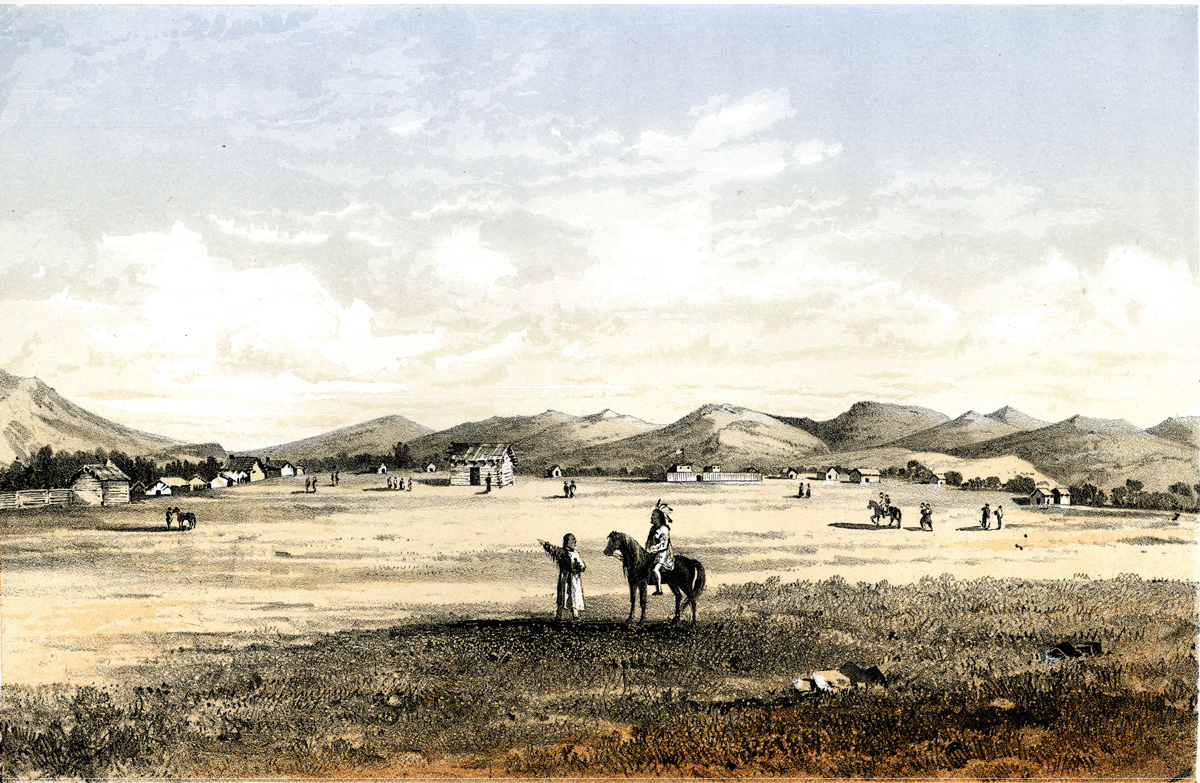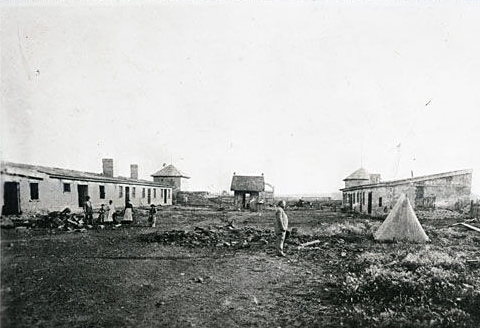. . . a man, brave, generous, and of sterling integrity.
Establishing Fort Owen
“Fort Owen—Flathead Village”
by John Mix Stanley (1814–1872)
Archives and Special Collections, Maureen and Mike Mansfield Library, The University of Montana, Missoula.
Plate 30 (ca. 1854)[1]United States War Department, Reports of explorations and surveys, to ascertain the most practicable and economical route for a railroad from the Mississippi River to the Pacific Ocean (Washington, … Continue reading. Original size, 9 by 5.7 inches.
Fort Owen is in the distance just above the head of the Indian on horseback. It was not officially a military fort, and thus was not protected by soldiers. However, like all trading establishments in the far west in the mid-19th century, it was built for defense. Although Blackfeet war parties harassed and killed some of the Flathead (i.e., Salish) people camped nearby, they never attacked Fort Owen.
In the fall of 1850 a 32-year-old former army sutler from Pennsylvania named John Owen arrived in the valley of the Bitterroot River with his common-law Shoshone wife, Nancy. They made the harrowing journey by ox-cart from Fort Hall, on the Snake River near present-day Pocatello, Idaho. Having heard of the varied attractions of the Bitterroot Valley—which the men of Isaac Stevens’s western railroad survey were soon to characterize as “the valley of perennial spring”[2]Reports of Explorations and surveys to ascertain the most practicable and economical route for a railroad from the Mississippi River to the Pacific Ocean, 12 vols. (Washington, D.C.: B. Tucker, … Continue reading—and bearing in mind its potential importance as a crossroads in western travel as well as the potential to capitalize on trade with Indians and emigrants, Owen paid $250, cash, for the physical remains of St. Mary’s Mission, which, as we shall soon learn, had opened in 1841 and closed nine years later. Immediately Owen began developing his property into what was to become, for a short time, one of the most important commercial centers in the Northwest. He named his stoutly palisaded trading post Fort Owen.
John Owen established his reputation as an honest businessman from the very beginning. His broader stature as a cultured man and a model citizen was reflected in the size and quality of his personal library, which John Mullan claimed was the finest to be seen anywhere in the northwest. It contained numerous general reference works, and many volumes on history. It included works of Byron, Milton, Dickens, Washington Irving, Charles Darwin and Sir Walter Scott. H. A. Washington’s 9-volume edition of The Writings of Thomas Jefferson was a major part of it, alongside Petrarch’s Sonnets and Odes and Plutarch’s Lives.[3]George F. Weisel, ed., Men and Trade on the Northwest Frontier as Shown by the Fort Owen Ledger (Missoula: Montana State University Press, 1955), 247-49. Owen’s broad tastes in literature provided him with the ability to maintain daily accounting ledgers that are rich in the history of life on the earliest western frontier—commodities, business practices, supply problems, and rosters of men of all descriptions whose lives intersected with his inside the sturdy confines of his trading post. Owen’s business required him to travel widely and often in order to keep his post supplied. Between 1851 and 1864 he made 34 inter-regional trips by pack-train totaling some 23,000 miles. He went to Walla Walla, The Dalles and Fort Vancouver via both the northern and southern Nez Perce trails, the trail now paralleled by Interstate 90, and the Clark Fork-Pend d’Oreille Lake route. Eastward, he went to Fort Benton, the uppermost terminal of steamboat traffic on the Missouri, by way of Lewis and Clark Pass, Hell Gate Pass, and Cadotte’s Pass.[4]Phillips, Journals and Letters, Map No. 2. The Missoula pioneer, Judge Frank Woody, explained that Owen would go to The Dalles, and Fort Vancouver via the Clark’s Fork and Pend d’Oreille … Continue reading
Owen’s Lolos
Remains of Fort Owen in 1908
To see labels, point to the image.
Archives and Special Collections, Maureen and Mike Mansfield Library, The University of Montana, Missoula
Photo © 1908 by J. Dagenais from the collection of photographer R. H. McKay.
Owen’s first structures, dating from 1850, were made of logs. In 1856 he began rebuilding and expanding the fort with mud adobe bricks made on the site. The gate in the south wall was the sole entrance to the compound. The west barrack, which was built first but no longer exists, contained the post’s kitchen, dining room, and trade room.[5]The word “barrack” suggests military occupancy, but there were never any soldiers billeted at Fort Owen. The east barrack, which was restored in the 1960s, contained five rooms: Owen’s quarters, his office and library, and guest rooms.
The two bastions, typical defense strongholds in frontier forts, both military and trading, included loopholes or ports from which rifles could be fired. However Owen never had need of them, for there were no armed threats ever made by Blackfeet Indians from the time John moved into the St. Mary’s Mission facilities. In fact, the west bastion (photo right) was used as a granery, while the west bastion was used for general storage including medical supplies, and a doctor’s office. The well house was built in 1860.
The name Lolo appeared numerous times in John Owen’s ledgers and letters. He consistently identified the nearby stream as the “Lo Lo fork,” and four or five times as “Lolo’s fork,” the latter again confirming that the creek was named for a person called Lolo. Also, Owen was the first on record to identify the Indian road that paralleled the creek as the “Lolo fork trail.”
An Indian named Lolo worked for him under a commis (clerk) named Jackson whom Owen hired in September 1854 at Canon River near the Washington coast, 20 miles northeast of Long Beach. On their way back to Fort Owen, on a night the brigade was camped at Ross Hole near the headwaters of the Bitterroot River, Jackson returned to his lodge at the close of day to discover, as Owen wrote in his journal, “that rascal Lolo was . . . very comfortably stowed away in the bed with Mrs. Jackson.”[6]Paul Phillips, ed., The Journals and Letters of Major John Owen, Pioneer of the Northwest, 1850-1871, 2 vols. (New York: Edward Eberstadt, 1927), 95. She confessed that the two of them had made plans to steal some horses and elope. Owen’s note on the incident was dated November 22, the day the party arrived back at the Fort; Mr. Jackson resigned the next morning and hit the road with his wife. Whether that Lolo hung around or took off too was not recorded.
The following March 26 Owen set out for Fort Vancouver with a string of 31 horses loaded with furs to be traded for supplies. He hired an American crew boss named George Goodwin, and took along three or four Salish men as packers—Palchimo, Lolo, Charley, and Big Mat. Editor George Weisel inserted the comma between Lolo and Charley, which Owen had omitted. On the other hand, editor Paul Phillips read them as one man’s name, “Lolo Charley.”[7]Weisel, 58, 96, 106. Paul Phillips, The Journals and Letters of Major John Owen, Pioneer of the Northwest, 1850-1871, 2 vols. (New York: Edward Eberstadt, 1827), 1:96. Palchimo (also Palchana, … Continue reading Ambiguities such as these, combined with the absence of any further identifications, make it impossible to determine exactly how many different Lolos there were.
On 14 July 1854 Owen set out on a business trip to the markets at The Dalles, with a pack string of 11 mules and 8 horses. He hired “Batiste, Lolo & Loui the Son of Piere” as wranglers. Lolo and Loui were paired up again on 5 January 1856, when they arrived together “from the Flat Head Camp.”[8]“Loui” may have been Louis Clairmont, a French-Canadian born in 1838, who arrived at Fort Owen in 1858. He first worked at odd jobs for the Major, such as making adobe bricks, but … Continue reading
Owen’s Later Life
John Owen’s health began to deteriorate after his wife died in 1868, and by 1871 he was diagnosed as suffering “dementia.” Three years later he was transported to a hospital in Helena, where he was declared legally insane, and sent to his family home in Philadelphia, where he died in 1889. Washington J. McCormick (1835-1889), a frontier pioneer, attorney, and entrepreneur, purchased Owen’s trading post in 1874. There were no further references to anyone named Lolo in the post’s records.
Notes
| ↑1 | United States War Department, Reports of explorations and surveys, to ascertain the most practicable and economical route for a railroad from the Mississippi River to the Pacific Ocean (Washington, D.C.: Thomas H. Ford, 1860), Vol. 12, Book I, p. 122. |
|---|---|
| ↑2 | Reports of Explorations and surveys to ascertain the most practicable and economical route for a railroad from the Mississippi River to the Pacific Ocean, 12 vols. (Washington, D.C.: B. Tucker, Printer, 1859), I:346. |
| ↑3 | George F. Weisel, ed., Men and Trade on the Northwest Frontier as Shown by the Fort Owen Ledger (Missoula: Montana State University Press, 1955), 247-49. |
| ↑4 | Phillips, Journals and Letters, Map No. 2. The Missoula pioneer, Judge Frank Woody, explained that Owen would go to The Dalles, and Fort Vancouver via the Clark’s Fork and Pend d’Oreille Lake, and return by an Indian road over the Coeur d’Alene Mountains. F. O. Woody, “Sketch of the Early History of Western Montana,” in Contributions to the Historical Society of Montana (Helena: State Publishing Company, 1896), 2:92. |
| ↑5 | The word “barrack” suggests military occupancy, but there were never any soldiers billeted at Fort Owen. |
| ↑6 | Paul Phillips, ed., The Journals and Letters of Major John Owen, Pioneer of the Northwest, 1850-1871, 2 vols. (New York: Edward Eberstadt, 1927), 95. |
| ↑7 | Weisel, 58, 96, 106. Paul Phillips, The Journals and Letters of Major John Owen, Pioneer of the Northwest, 1850-1871, 2 vols. (New York: Edward Eberstadt, 1827), 1:96. Palchimo (also Palchana, Palchina) was a Salish chief considered by Owen to be the best horse trainer and veterinarian anywhere around. Nothing more than the name is known of “Big Mat.” |
| ↑8 | “Loui” may have been Louis Clairmont, a French-Canadian born in 1838, who arrived at Fort Owen in 1858. He first worked at odd jobs for the Major, such as making adobe bricks, but sometime after 1860 he settled down to farming about eight miles southeast of the Fort. Weisel, 179. |


